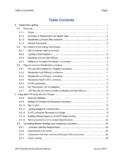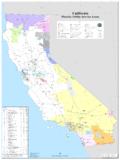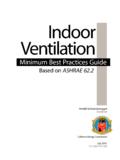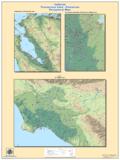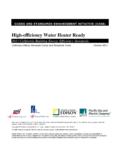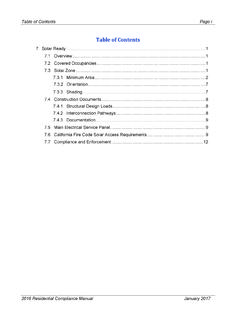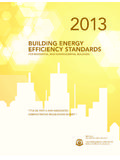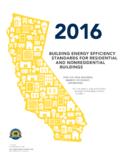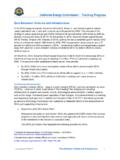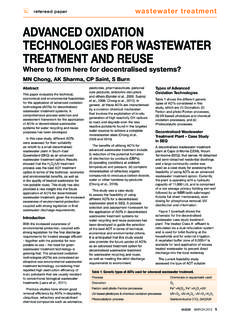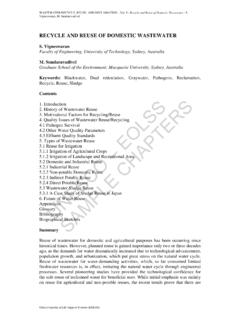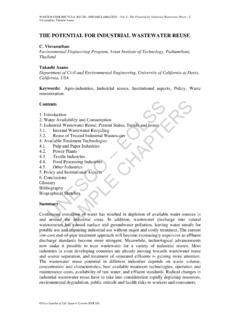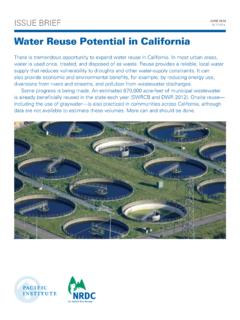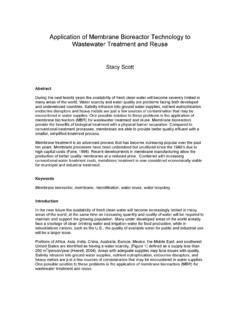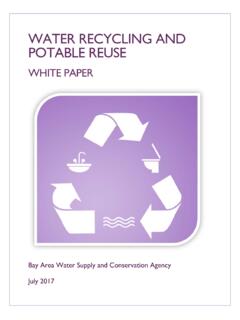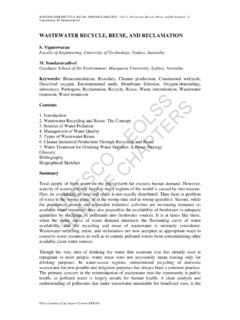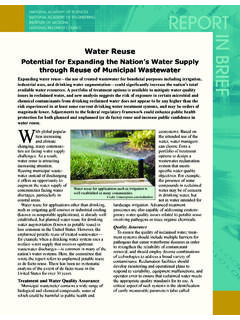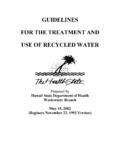Transcription of INTEGRATED INDUSTRIAL WASTEWATER REUSE BY HEAT …
1 Energy Research and Development Division FINAL PROJECT REPORT INTEGRATED INDUSTRIAL WASTEWATER REUSE BY HEAT RECOVERY MARCH 2015 CEC-500- 2015- 049 Prepared for: California Energy Commission Prepared by: Gas Technology Institute PREPARED BY: Primary Author(s): Yaroslav Chudnovsky, PhD Aleksandr Kozlov, PhD, ScD Gas Technology Institute 1700 South Mount Prospect Road Des Plaines, IL 60018, USA Phone: 847-768-0536 | Fax: 847-768-0916 Contract Number: PIR-09-004 Prepared for: California Energy Commission Rajesh Kapoor Contract Manager Virginia Lew Office Manager Energy Eficiency Research Office Laurie ten Hope Deputy Director ENERGY RESEARCH AND DEVELOPMENT DIVISION Robert P. Oglesby Executive Director DISCLAIMER This report was prepared as the result of work sponsored by the California Energy Commission.
2 It does not necessarily represent the views of the Energy Commission, its employees or the State of California. The Energy Commission, the State of California, its employees, contractors and subcontractors make no warranty, express or implied, and assume no legal liability for the information in this report; nor does any party represent that the uses of this information will not infringe upon privately owned rights. This report has not been approved or disapproved by the California Energy Commission nor has the California Energy Commission passed upon the accuracy or adequacy of the information in this report. ACKNOWLEDGEMENTS The authors acknowledge the California Energy Commission (PIR-09-004) and the members of Utilization Technology Development NFP for their financial support of this challenging effort.
3 The authors also wish to express thanks to Dr. Valeriy Maisotsenko and Leland Gillan, PE, both of Idalex Technologies, Inc. as well as to James Harris, PE, of Intevras Technologies, LLC for donating their valuable time and thoughts along with great advisory assistance to this work. i PREFACE The California Energy Commission Energy Research and Development Division supports public interest energy research and development that will help improve the quality of life in California by bringing environmentally safe, affordable, and reliable energy services and products to the marketplace. The Energy Research and Development Division conducts public interest research, development, and demonstration (RD&D) projects to benefit California. The Energy Research and Development Division strives to conduct the most promising public interest energy research by partnering with RD&D entities, including individuals, businesses, utilities, and public or private research institutions.
4 Energy Research and Development Division funding efforts are focused on the following RD&D program areas: Buildings End-Use Energy Efficiency Energy Innovations Small Grants Energy-Related Environmental Research Energy Systems Integration Environmentally Preferred Advanced Generation INDUSTRIAL /Agricultural/Water End-Use Energy Efficiency Renewable Energy Technologies Transportation INTEGRATED INDUSTRIAL WASTEWATER REUSE By Heat Recovery is the final report for the INTEGRATED Waste Heat and WASTEWATER Recovery DOME for Food Processing Applications project (contract number PIR-09-004) conducted by Gas Technology Institute. The information from this project contributes to Energy Research and Development Division s INDUSTRIAL /Agricultural/Water End-Use Energy Efficiency Program. For more information about the Energy Research and Development Division, please visit the Energy Commission s website at or contact the Energy Commission at 916-327-1551.
5 Ii ABSTRACT This report presents results from evaluating WASTEWATER recovery and REUSE technology that could lead to substantial water savings along with increased energy efficiency in California s food processing industry. WASTEWATER recovery and REUSE technologies have expanded rapidly in recent decades. A variety of technologies, primarily thermal and membrane processes have been developed for different INDUSTRIAL applications. This project evaluated various WASTEWATER distillation techniques for application to the food processing industry. This project demonstrated a cost-effective and efficient technology concept that combines WASTEWATER recovery and waste heat use. A novel distillation technique for WASTEWATER REUSE via heat recovery was developed and experimentally evaluated. The main component of the new WASTEWATER and waste heat recovery system is a plate heat-mass-exchange module that has been successfully used for evaporative air conditioning applications.
6 The heat-mass-exchange module uses a multilayer design composed of parallel perforated plastic plates. These plates create an air counter flow/cross flow thermodynamic design between the air streams in dry, evaporating, and condensing channels. WASTEWATER is evaporated at a low temperature and condensed with atmospheric air in the heat-mass-exchange module at ambient pressure and without boiling. Waste heat is used to preheat the WASTEWATER to increase the efficiency of the distillation process. Laboratory experiments on the new distillation unit achieved a high WASTEWATER distillation rate of 55 percent. This new technology significantly increases the energy efficiency of WASTEWATER recycling and reduces electricity consumption associated with conventional WASTEWATER recovery methods. Successful development and commercialization of the technology for food processing applications would provide substantial energy and water savings to the industry by increasing energy efficiency and reducing pumping power for process water supply.
7 Integrating waste heat recovery with WASTEWATER REUSE also leads to reducing product costs for California food processors. Keywords: WASTEWATER , waste heat, REUSE , recovery, recycling, utilization, energy efficiency, distillation, heat-mass-exchange Please use the following citation for this report: Chudnovsky, Yaroslav; Aleksandr Kozlov (Gas Technology Institute). 2014. INTEGRATED INDUSTRIAL WASTEWATER REUSE Via Heat Recovery. California Energy Commission. Publication number: CEC-500-2015-049 iii TABLE OF CONTENTS Acknowledgements .. i PREFACE .. ii ABSTRACT .. iii TABLE OF CONTENTS .. iv LIST OF FIGURES .. v LIST OF TABLES .. v EXECUTIVE SUMMARY .. 1 Introduction .. 1 Project Purpose and Objectives .. 2 Project Results .. 2 Project Benefits .. 3 CHAPTER 1: INTEGRATED WASTEWATER REUSE by Heat Recovery .. 5 Scientific and Technical Baseline for INTEGRATED WASTEWATER REUSE via Heat Recovery.
8 5 State-of -the-Art WASTEWATER Recovery .. 13 Reverse Osmosis (RO) .. 14 Atmospheric Distillation by Water Boiling (AD) .. 15 Mechanical Vapor Compression (MVC) .. 15 Vacuum Distillation (VD) .. 16 Multistage Flash (MSF) Distillation .. 17 INTEGRATED Multi-Effect Distillation with Thermal Vapor Compression (IMED-TVC) 18 Advanced Approaches .. 19 Vacuum Distillation with Heat Pump (VDHP) .. 19 Low Temperature Evaporation with Water Separation Membrane (WSM) .. 21 Technologies Comparison .. 24 CHAPTER 2: Novel Indirect Dew Point Evaporation System for WASTEWATER Recovery and REUSE .. 25 Indirect Dew Point Evaporation 25 iv Distillation Unit Development and Design .. 25 Laboratory Scale Unit Test Setup .. 29 Methodology of Evaluation .. 31 Results and Discussions .. 32 Conclusions.
9 34 GLOSSARY .. 36 REFERENCES .. 37 APPENDIX A: Acronyms List .. A-1 APPENDIX B: Example of WASTEWATER Effluent Quality for California Food Processing Plant .. B-1 APPENDIX C Fundamentals for Dew Point Evaporative C-1 APPENDIX D Fiber and Fiber Characteristics for Idalex s HMX .. D-1 APPENDIX E Distillation Unit Design and Fabrication .. E-1 LIST OF FIGURES Figure 1: Total Energy Supply for the Food and Beverage Industry .. 7 Figure 2: Effects of INTEGRATED Energy and Water Usage Assessment .. 12 Figure 3: WASTEWATER and Waste Heat Recovery Process for a Fresh Onion Processing Plant: Dashed Lines Prospective WASTEWATER and Waste Heat Recovery System .. 13 Figure 4: Vacuum Distillation with Low Grade Heat (Gude and Nirmalakhandan, 2009): WT WASTEWATER Tank; BT Brine Tank; DWT Distilled Water Tank .. 17 Figure 5: Vacuum Distillation of WASTEWATER With a Heat Pump For Condensation Heat Recycle.
10 20 Figure 6: Low Temperature Evaporation With Water Separation Membrane .. 22 Figure 7: Low-Temperature WASTEWATER Concentrator/Cleanup Process with Water Condensation .. 23 Figure 8: Indirect Dew-Point Evaporative Concept for Water Distillation .. 26 Figure 9: Idalex s HMX Views and Overall Dimensions .. 26 Figure 10: HMX Unit Multilayer Design and Flow Structure .. 27 Figure 11: HMX Unit Flow Diagram (Top View): (a) Initial and (b) Rearranged Air 28 v Figure 12: Real-Time Monitoring Scheme of the Distillation System for WASTEWATER Recovery:P Pressure; T Temperature; H Humidity .. 29 Figure 13: Overview of the Distillation Unit Test Setup at GTI Laboratory .. 30 Figure 14: Packing Fill (a) and Hot Water Supply to the Fill (b) .. 30 Figure 17: WASTEWATER (a) and Condensate (b) .. 34 LIST OF TABLES Table 1: Estimated Annual Water and Energy Use of Major Food Processing Sectors in California (California Energy Commission Roadmap 500-2006-073).
